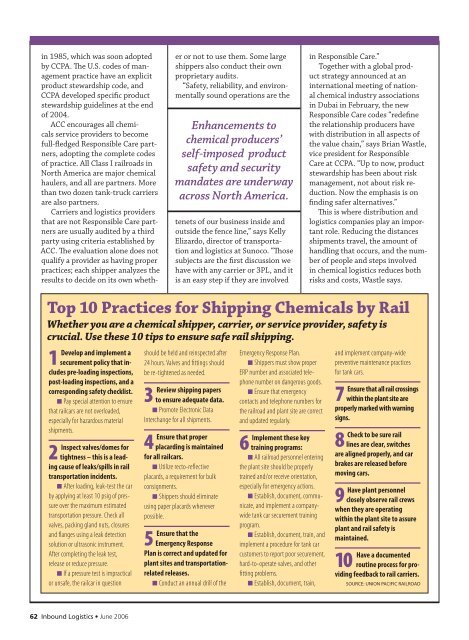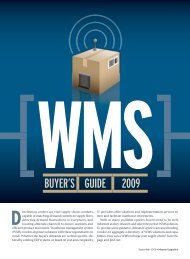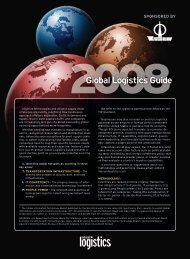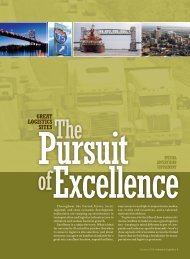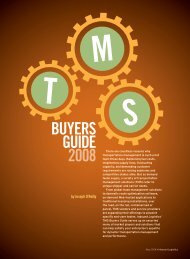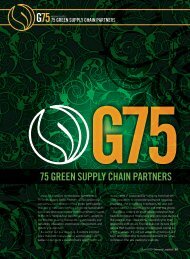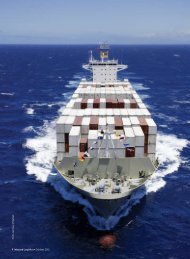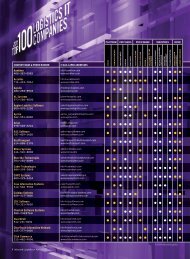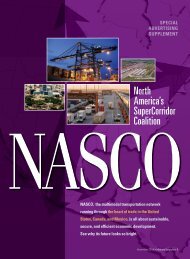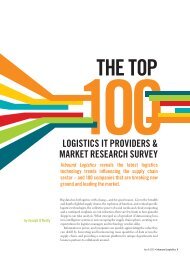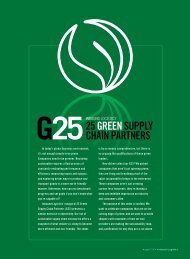Chemical Logistics - Inbound Logistics
Chemical Logistics - Inbound Logistics
Chemical Logistics - Inbound Logistics
You also want an ePaper? Increase the reach of your titles
YUMPU automatically turns print PDFs into web optimized ePapers that Google loves.
in 1985, which was soon adopted<br />
by CCPA. The U.S. codes of management<br />
practice have an explicit<br />
product stewardship code, and<br />
CCPA developed specific product<br />
stewardship guidelines at the end<br />
of 2004.<br />
ACC encourages all chemicals<br />
service providers to become<br />
full-fledged Responsible Care partners,<br />
adopting the complete codes<br />
of practice. All Class I railroads in<br />
North America are major chemical<br />
haulers, and all are partners. More<br />
than two dozen tank-truck carriers<br />
are also partners.<br />
Carriers and logistics providers<br />
that are not Responsible Care partners<br />
are usually audited by a third<br />
party using criteria established by<br />
ACC. The evaluation alone does not<br />
qualify a provider as having proper<br />
practices; each shipper analyzes the<br />
results to decide on its own whether<br />
or not to use them. Some large<br />
shippers also conduct their own<br />
proprietary audits.<br />
“Safety, reliability, and environmentally<br />
sound operations are the<br />
Enhancements to<br />
chemical producers’<br />
self-imposed product<br />
safety and security<br />
mandates are underway<br />
across North America.<br />
tenets of our business inside and<br />
outside the fence line,” says Kelly<br />
Elizardo, director of transportation<br />
and logistics at Sunoco. “Those<br />
subjects are the first discussion we<br />
have with any carrier or 3PL, and it<br />
is an easy step if they are involved<br />
in Responsible Care.”<br />
Together with a global product<br />
strategy announced at an<br />
international meeting of national<br />
chemical industry associations<br />
in Dubai in February, the new<br />
Responsible Care codes “redefine<br />
the relationship producers have<br />
with distribution in all aspects of<br />
the value chain,” says Brian Wastle,<br />
vice president for Responsible<br />
Care at CCPA. “Up to now, product<br />
stewardship has been about risk<br />
management, not about risk reduction.<br />
Now the emphasis is on<br />
finding safer alternatives.”<br />
This is where distribution and<br />
logistics companies play an important<br />
role. Reducing the distances<br />
shipments travel, the amount of<br />
handling that occurs, and the number<br />
of people and steps involved<br />
in chemical logistics reduces both<br />
risks and costs, Wastle says.<br />
Top 10 Practices for Shipping <strong>Chemical</strong>s by Rail<br />
Whether you are a chemical shipper, carrier, or service provider, safety is<br />
crucial. Use these 10 tips to ensure safe rail shipping.<br />
1<br />
Develop and implement a<br />
securement policy that includes<br />
pre-loading inspections,<br />
post-loading inspections, and a<br />
corresponding safety checklist.<br />
n Pay special attention to ensure<br />
that railcars are not overloaded,<br />
especially for hazardous material<br />
shipments.<br />
2<br />
Inspect valves/domes for<br />
tightness – this is a leading<br />
cause of leaks/spills in rail<br />
transportation incidents.<br />
n After loading, leak-test the car<br />
by applying at least 10 psig of pressure<br />
over the maximum estimated<br />
transportation pressure. Check all<br />
valves, packing gland nuts, closures<br />
and flanges using a leak detection<br />
solution or ultrasonic instrument.<br />
After completing the leak test,<br />
release or reduce pressure.<br />
n If a pressure test is impractical<br />
or unsafe, the railcar in question<br />
should be held and reinspected after<br />
24 hours. Valves and fittings should<br />
be re-tightened as needed.<br />
3<br />
Review shipping papers<br />
to ensure adequate data.<br />
n Promote Electronic Data<br />
Interchange for all shipments.<br />
4<br />
Ensure that proper<br />
placarding is maintained<br />
for all railcars.<br />
n Utilize recto-reflective<br />
placards, a requirement for bulk<br />
consignments.<br />
n Shippers should eliminate<br />
using paper placards whenever<br />
possible.<br />
5<br />
Ensure that the<br />
Emergency Response<br />
Plan is correct and updated for<br />
plant sites and transportationrelated<br />
releases.<br />
n Conduct an annual drill of the<br />
Emergency Response Plan.<br />
n Shippers must show proper<br />
ERP number and associated telephone<br />
number on dangerous goods.<br />
n Ensure that emergency<br />
contacts and telephone numbers for<br />
the railroad and plant site are correct<br />
and updated regularly.<br />
6<br />
Implement these key<br />
training programs:<br />
n All railroad personnel entering<br />
the plant site should be properly<br />
trained and/or receive orientation,<br />
especially for emergency actions.<br />
n Establish, document, communicate,<br />
and implement a companywide<br />
tank car securement training<br />
program.<br />
n Establish, document, train, and<br />
implement a procedure for tank car<br />
customers to report poor securement,<br />
hard-to-operate valves, and other<br />
fitting problems.<br />
n Establish, document, train,<br />
and implement company-wide<br />
preventive maintenance practices<br />
for tank cars.<br />
7<br />
Ensure that all rail crossings<br />
within the plant site are<br />
properly marked with warning<br />
signs.<br />
8<br />
Check to be sure rail<br />
lines are clear, switches<br />
are aligned properly, and car<br />
brakes are released before<br />
moving cars.<br />
9<br />
Have plant personnel<br />
closely observe rail crews<br />
when they are operating<br />
within the plant site to assure<br />
plant and rail safety is<br />
maintained.<br />
10<br />
Have a documented<br />
routine process for providing<br />
feedback to rail carriers.<br />
SOURCE: UNION PACIFIC RAILROAD<br />
62 <strong>Inbound</strong> <strong>Logistics</strong> • June 2006


